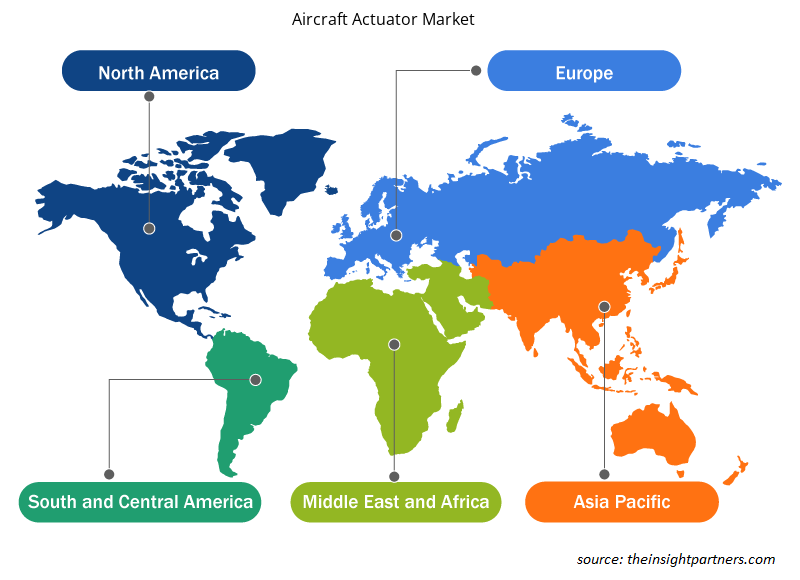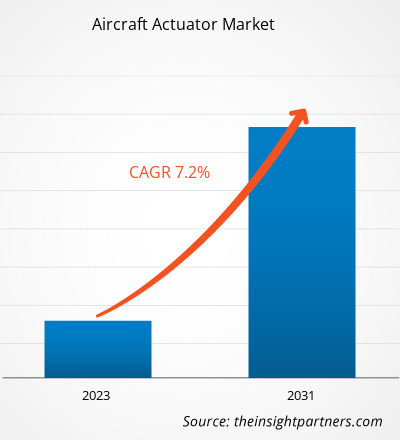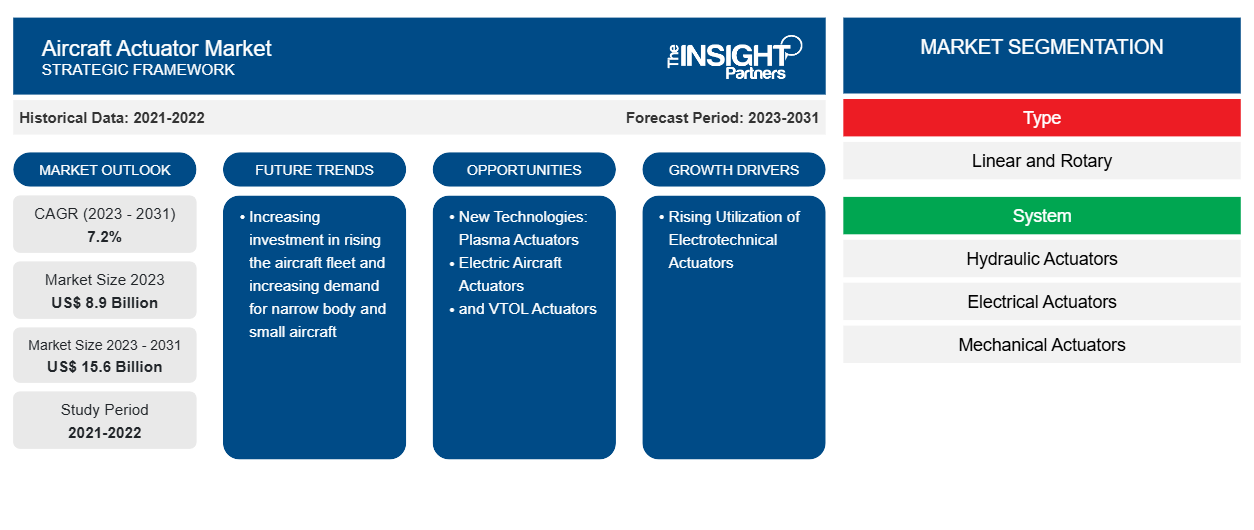Le marché des actionneurs d'aéronefs devrait atteindre 15,6 milliards de dollars américains d'ici 2031, contre 8,9 milliards de dollars américains en 2023. Le marché devrait enregistrer un TCAC de 7,2 % entre 2023 et 2031. L'augmentation des investissements dans l'augmentation de la flotte d'aéronefs et la demande croissante d'avions à fuselage étroit et de petits avions sont parmi les principaux facteurs qui stimulent le marché des actionneurs d'aéronefs.
Analyse du marché des actionneurs d'aéronefs
La croissance du marché des actionneurs d'aéronefs est principalement tirée par des investissements importants dans les technologies de pointe dans l'industrie aéronautique. Au cours des vingt dernières années, l'industrie de l'aviation (commerciale et militaire) a connu une croissance significative. Le taux de transformation technologique a été exceptionnel, ce qui a augmenté la demande de divers produits et services. On constate une augmentation de l'adoption de solutions d'actionneurs d'aéronefs dans les avions commerciaux en raison de l'augmentation de la demande d'amélioration des systèmes de contrôle de vol et des trains d'atterrissage. Le nombre croissant d'accidents d'aéronefs et l'amélioration des normes réglementaires de sécurité ont mis en évidence l'importance des actionneurs d'aéronefs. Pour améliorer le niveau de performance, les avions adoptent des systèmes d'actionnement électromécaniques avancés. Les actionneurs électromécaniques connaissent une croissance considérable sur le marché à mesure que les constructeurs aéronautiques évoluent vers l'intégration de davantage de systèmes électriques dans les avions. En outre, les avancées dans les systèmes de contrôle des aéronefs, tels que la numérisation et la connectivité de l'Internet des objets (IoT), soutiennent la croissance du marché.
Aperçu du marché des actionneurs d'aéronefs
L'industrie des actionneurs d'aéronefs évolue en permanence avec des innovations dans les offres de produits pour fournir des systèmes d'actionnement plus petits, plus légers et rentables. La demande croissante d'actionneurs électromécaniques pour améliorer les processus d'actionnement propulse la croissance du marché. L'avènement des avions électriques crée une nouvelle opportunité pour les acteurs du marché de se concentrer sur le développement d'actionneurs d'aéronefs plus légers, plus petits et plus efficaces. En outre, la demande croissante de flottes d'avions de petite taille et à fuselage étroit des pays en développement comme des pays développés propulse la croissance du marché. L'électrification croissante des systèmes d'aéronefs avec une formulation hybride utilisant des systèmes mécaniques et hydrauliques stimule la croissance du marché des actionneurs d'aéronefs.
Personnalisez ce rapport en fonction de vos besoins
Vous bénéficierez d'une personnalisation gratuite de n'importe quel rapport, y compris de certaines parties de ce rapport, d'une analyse au niveau des pays, d'un pack de données Excel, ainsi que de superbes offres et réductions pour les start-ups et les universités.
- Obtenez les principales tendances clés du marché de ce rapport.Cet échantillon GRATUIT comprendra une analyse de données, allant des tendances du marché aux estimations et prévisions.
Facteurs moteurs et opportunités du marché des actionneurs d'aéronefs
Utilisation croissante des actionneurs électrotechniquesElectrotechnical Actuators
Les systèmes de contrôle de vol des avions passent de systèmes hydrauliques volumineux, lourds et fuyants à des systèmes autonomes électriques. Les progrès des actionneurs électromécaniques (EM), tels que la fiabilité, la nature compacte, la légèreté et la rentabilité, augmentent son adoption dans les avions. Les flottes d'avions commerciaux et militaires recherchent des systèmes avancés plus légers pour améliorer le rendement énergétique. Les actionneurs des avions sont utilisés dans la fonctionnalité du train d'atterrissage , des becs et des spoilers, des sièges, des volets, du positionnement des aubes directrices d'admission du moteur, du gouvernail de direction, des ailerons et de l'ouverture et de la fermeture des portes de soute ou de soute, entre autres. Étant donné que les constructeurs d'avions mettent de plus en plus l'accent sur les modèles d'avions légers, les actionneurs électromécaniques attirent les constructeurs dans le scénario actuel, ce qui catalyse le marché des actionneurs d'avions. Une autre raison de l'adoption croissante des actionneurs électromécaniques est le changement de paradigme de l'industrie aérospatiale vers les avions électriques, qui rend obsolètes les systèmes hydrauliques, pneumatiques et mécaniques et augmente l'adoption des systèmes d'actionnement électriques. Cette tendance génère une demande substantielle en actionneurs électriques, ce qui stimule en fin de compte le marché des actionneurs d’aéronefs.electromechanical (EM) actuators, such as reliability, compact nature, lightweight, and cost-efficiency, are mounting its adoption in aircraft. Commercial and military aircraft fleets are looking for advanced systems that are lighter in weight to enhance fuel efficiency. Actuators in aircraft are used in the functionality of OEMs are increasingly emphasizing lightweight aircraft models, electromechanical actuators are attracting OEMs in the current scenario, which is catalyzing the aircraft actuators market. Another reason for the increasing adoption of electromechanical actuators is the paradigm shift of the aerospace industry toward electric aircraft, which is obsoleting the hydraulic, pneumatic, and mechanical systems and is increasing the adoption of electric actuation systems. This trend is generating substantial demand for electrical actuators, which is ultimately boosting the aircraft actuators market.
Nouvelles technologies : actionneurs à plasma, actionneurs électriques pour avions et actionneurs VTOL
L'industrie des actionneurs d'aéronefs a évolué des systèmes d'actionneurs pneumatiques et hydrauliques aux systèmes d'actionneurs électriques. Alors que la flotte d'aéronefs se tourne vers des sources d'énergie propres, l'adoption de l'énergie électrique est en plein essor dans l'industrie aéronautique pour réduire les émissions. L'avènement des avions électriques crée une nouvelle tendance des actionneurs électriques sur le marché. Par exemple, en décembre 2020, la société Curtiss-Wright a reçu la commande de fournir la technologie d'actionnement des commandes de vol primaires pour l'avion de transport urbain entièrement électrique d'Alice. La société propose une conception EMA commerciale prête à l'emploi (COTS) qui est plus légère, rentable et réduit le risque du programme. De plus, les systèmes hydrauliques et pneumatiques sont plus volumineux, ce qui augmente le poids et entraîne une augmentation de la consommation de carburant. Par conséquent, l'industrie aéronautique utilise des actionneurs électriques légers pour réduire la consommation de carburant supplémentaire causée par les systèmes lourds.Curtiss-Wright company received the order to provide primary flight control actuation technology for Alice's all-electric commuter aircraft. The company is offering a commercial-off-the-shelf (COTS) EMA design that is lighter, cost-effective and reduces the program risk. Further, hydraulic and pneumatic systems are bulkier, which increases the weight and results in increased fuel consumption. Hence, the aircraft industry is using lightweight electric actuators to reduce additional fuel consumption caused by heavy systems.
Analyse de segmentation du rapport sur le marché des actionneurs d'aéronefs
Les segments clés qui ont contribué à la dérivation de l’analyse du marché des actionneurs d’aéronefs sont le type, le système et l’utilisateur final.
- En fonction du type, le marché des actionneurs d'aéronefs a été divisé en linéaire et rotatif. Le segment linéaire détenait une part de marché plus importante en 2023.
- En fonction du système, le marché des actionneurs d'aéronefs a été divisé en actionneurs hydrauliques, actionneurs électriques, actionneurs mécaniques et actionneurs pneumatiques. Le segment des actionneurs pneumatiques détenait une part de marché plus importante en 2023.
- Sur la base de l'utilisateur final, le marché a été segmenté en avions commerciaux et avions militaires. Le segment des avions commerciaux détenait la plus grande part de marché en 2023.
Analyse des parts de marché des actionneurs d'aéronefs par géographie
La portée géographique du rapport sur le marché des actionneurs d’aéronefs est principalement divisée en cinq régions : Amérique du Nord, Europe, Asie-Pacifique, Moyen-Orient et Afrique et Amérique du Sud.
L'Amérique du Nord a dominé le marché des actionneurs d'aéronefs en 2023. La région Amérique du Nord comprend les États-Unis, le Canada et le Mexique. L'industrie aérospatiale en Amérique du Nord a mûri en raison de la présence d'un grand nombre de constructeurs d'aéronefs, de fournisseurs de technologies d'actionneurs avancés et d'une main-d'œuvre qualifiée. Il existe une énorme demande de nouveaux systèmes de contrôle dans la région, car les utilisateurs finaux tels que les fabricants d'avions militaires et commerciaux sont bien conscients des nouvelles technologies. De ce fait, l'adoption de solutions d'actionneurs d'aéronefs électriques et hydrauliques dans les avions commerciaux est élevée et connaît une intégration accrue dans les nouveaux avions à fuselage étroit développés par les constructeurs aéronautiques. Le secteur de l'aérospatiale commerciale en Amérique du Nord est majoritairement dominé par Boeing, qui intègre également une large gamme d'actionneurs dans ses modèles B787 et B777 pour un contrôle de vol amélioré.
Aperçu régional du marché des actionneurs d'aéronefs
Les tendances et facteurs régionaux influençant le marché des actionneurs d’aéronefs tout au long de la période de prévision ont été expliqués en détail par les analystes d’Insight Partners. Cette section traite également des segments et de la géographie du marché des actionneurs d’aéronefs en Amérique du Nord, en Europe, en Asie-Pacifique, au Moyen-Orient et en Afrique, ainsi qu’en Amérique du Sud et en Amérique centrale.

- Obtenez les données régionales spécifiques au marché des actionneurs d'aéronefs
Portée du rapport sur le marché des actionneurs d'aéronefs
| Attribut de rapport | Détails |
|---|---|
| Taille du marché en 2023 | 8,9 milliards de dollars américains |
| Taille du marché d'ici 2031 | 15,6 milliards de dollars américains |
| Taux de croissance annuel composé mondial (2023-2031) | 7,2% |
| Données historiques | 2021-2022 |
| Période de prévision | 2023-2031 |
| Segments couverts | Par type
|
| Régions et pays couverts | Amérique du Nord
|
| Leaders du marché et profils d'entreprises clés |
|
Densité des acteurs du marché : comprendre son impact sur la dynamique des entreprises
Le marché des actionneurs d'aéronefs connaît une croissance rapide, tirée par la demande croissante des utilisateurs finaux en raison de facteurs tels que l'évolution des préférences des consommateurs, les avancées technologiques et une plus grande sensibilisation aux avantages du produit. À mesure que la demande augmente, les entreprises élargissent leurs offres, innovent pour répondre aux besoins des consommateurs et capitalisent sur les tendances émergentes, ce qui alimente davantage la croissance du marché.
La densité des acteurs du marché fait référence à la répartition des entreprises ou des sociétés opérant sur un marché ou un secteur particulier. Elle indique le nombre de concurrents (acteurs du marché) présents sur un marché donné par rapport à sa taille ou à sa valeur marchande totale.
Les principales entreprises opérant sur le marché des actionneurs d'aéronefs sont :
- Collins Aérospatiale
- Société Cutiss-Wright
- Eaton Corporation Plc
- Honeywell International Inc.
- Automate programmable Meggitt
- Moog Inc.
Avis de non-responsabilité : les sociétés répertoriées ci-dessus ne sont pas classées dans un ordre particulier.

- Obtenez un aperçu des principaux acteurs du marché des actionneurs d'aéronefs
Actualités et développements récents du marché des actionneurs d'aéronefs
Le marché des actionneurs d'aéronefs est évalué en collectant des données qualitatives et quantitatives après des recherches primaires et secondaires, qui comprennent d'importantes publications d'entreprise, des données d'association et des bases de données. Voici une liste des développements sur le marché des actionneurs d'aéronefs et des stratégies :
- En juin 2023, Supernal (une société de mobilité aérienne avancée) s'est associée à UMBRAGROUP. Grâce à ce partenariat, UMBRAGROUP fournira des actionneurs et de l'électronique de contrôle moteur pour le déploiement de l'architecture système des futurs véhicules de Supernal.
- En juillet 2022, Honeywell International, Inc. a signé un accord avec Archer Aviation Inc. Grâce à cet accord, Honeywell fournira des actionneurs et une technologie de système climatique pour les avions de production d'Archer.
Rapport sur le marché des actionneurs d'aéronefs : couverture et livrables
Le rapport « Taille et prévisions du marché des actionneurs d’aéronefs (2021-2031) » fournit une analyse détaillée du marché couvrant les domaines ci-dessous :
- Taille du marché et prévisions aux niveaux mondial, régional et national pour tous les segments de marché clés couverts par le périmètre
- Dynamique du marché, comme les facteurs moteurs, les contraintes et les opportunités clés
- Principales tendances futures
- Analyse détaillée des cinq forces de Porter
- Analyse du marché mondial et régional couvrant les principales tendances du marché, les principaux acteurs, les réglementations et les développements récents du marché
- Analyse du paysage industriel et de la concurrence couvrant la concentration du marché, l'analyse de la carte thermique, les principaux acteurs et les développements récents
- Profils d'entreprise détaillés avec analyse SWOT
- Analyse historique (2 ans), année de base, prévision (7 ans) avec TCAC
- Analyse PEST et SWOT
- Taille du marché Valeur / Volume - Mondial, Régional, Pays
- Industrie et paysage concurrentiel
- Ensemble de données Excel
Rapports récents
Témoignages
Raison d'acheter
- Prise de décision éclairée
- Compréhension de la dynamique du marché
- Analyse concurrentielle
- Connaissances clients
- Prévisions de marché
- Atténuation des risques
- Planification stratégique
- Justification des investissements
- Identification des marchés émergents
- Amélioration des stratégies marketing
- Amélioration de l'efficacité opérationnelle
- Alignement sur les tendances réglementaires





















 Obtenez un échantillon gratuit pour - Marché des actionneurs d'aéronefs
Obtenez un échantillon gratuit pour - Marché des actionneurs d'aéronefs